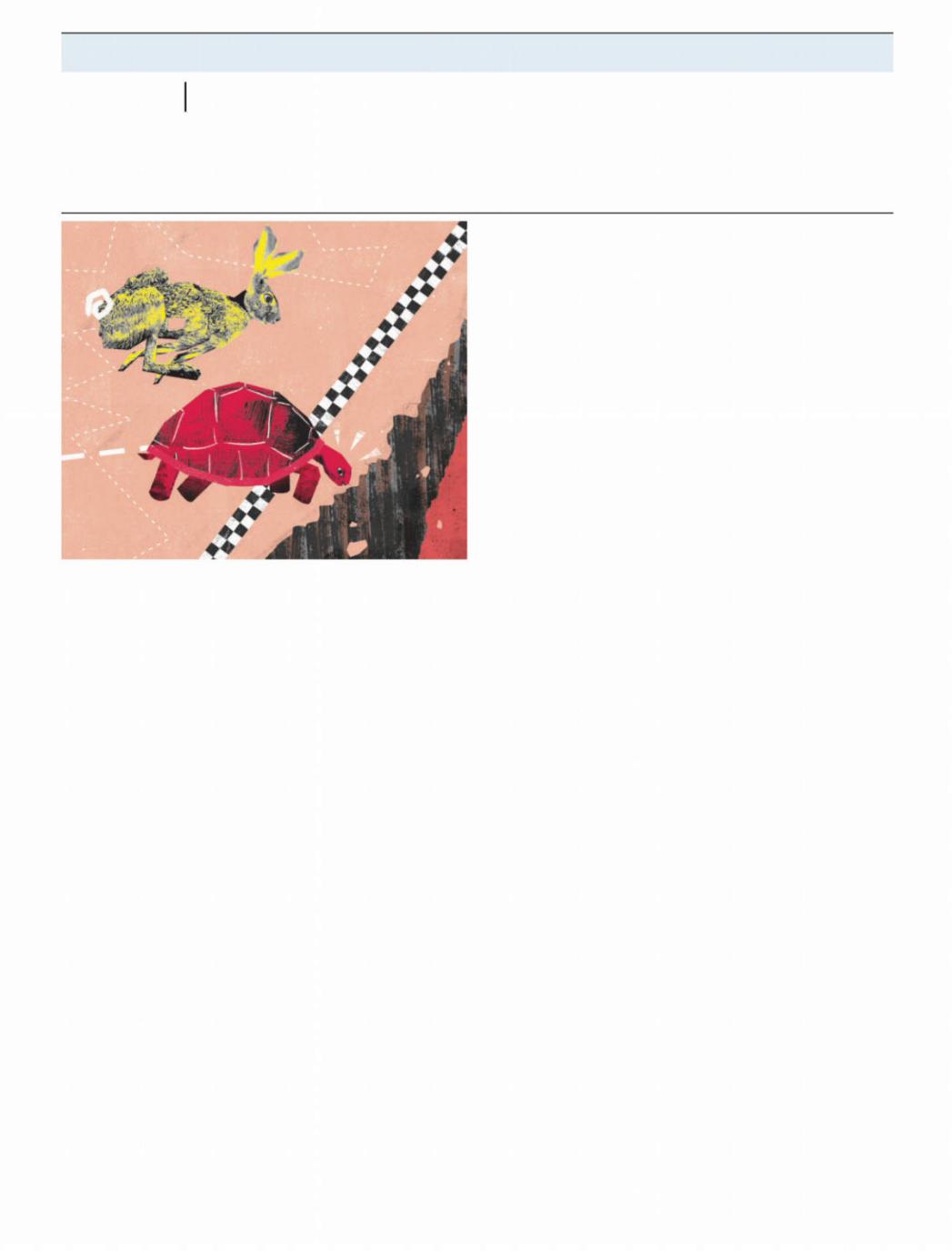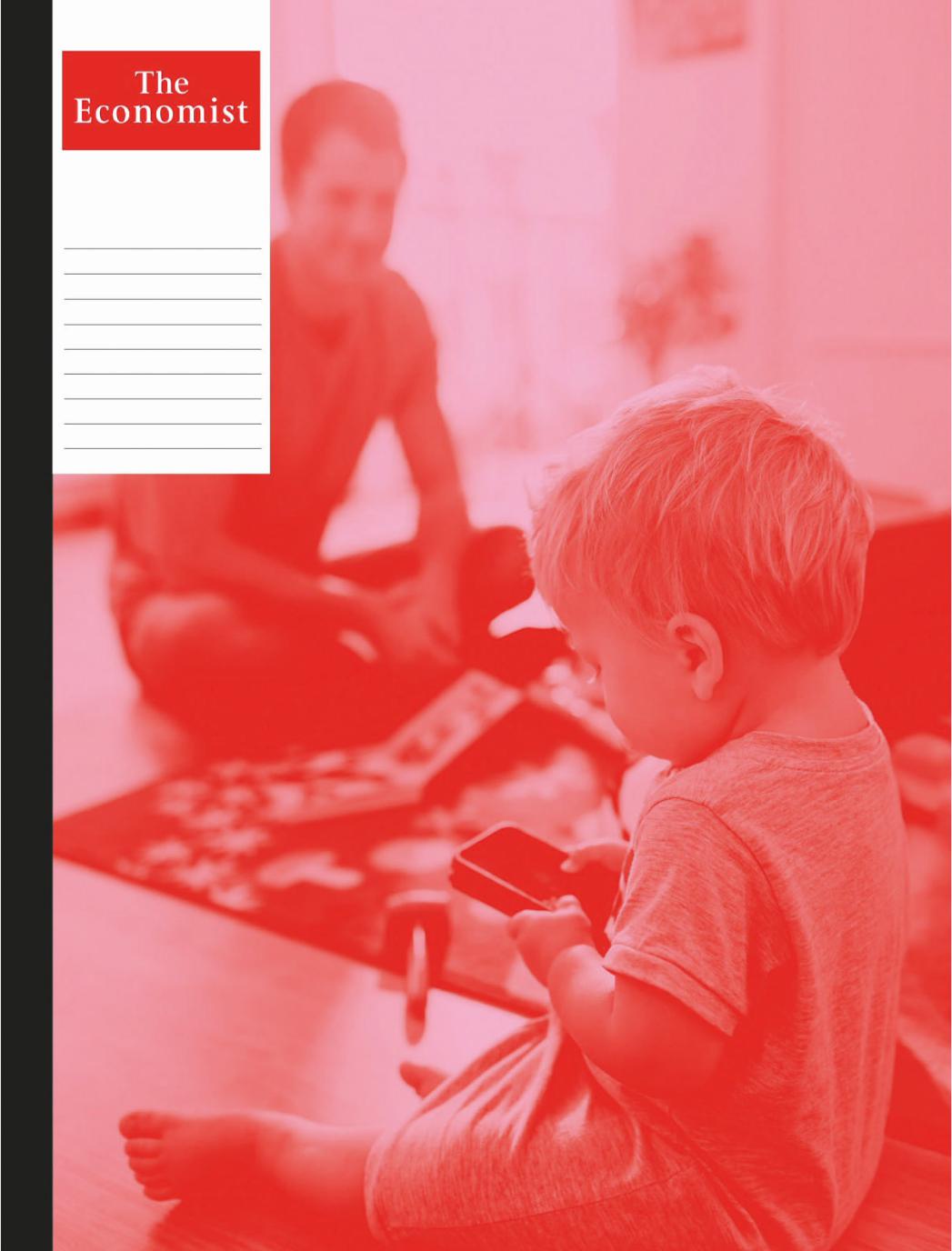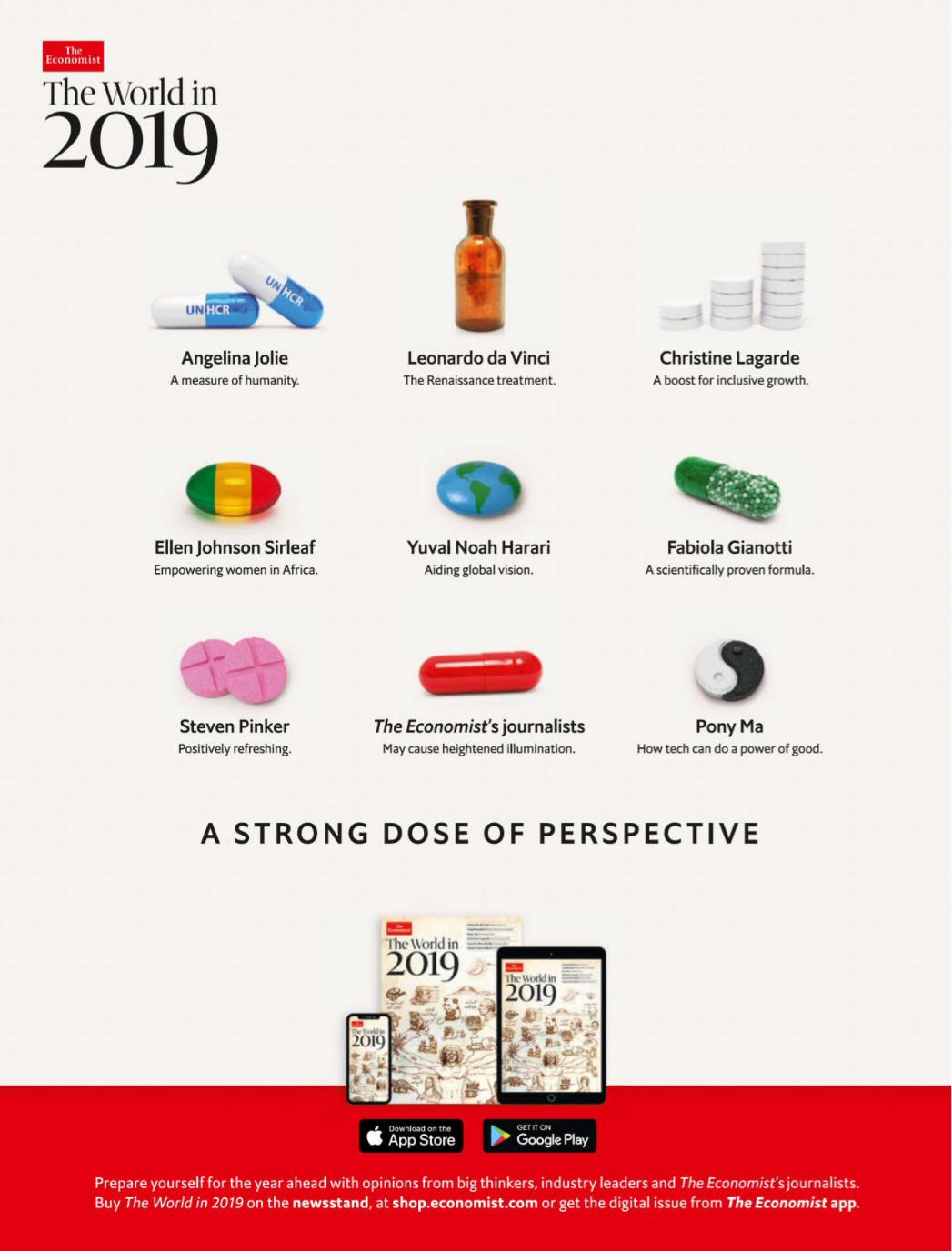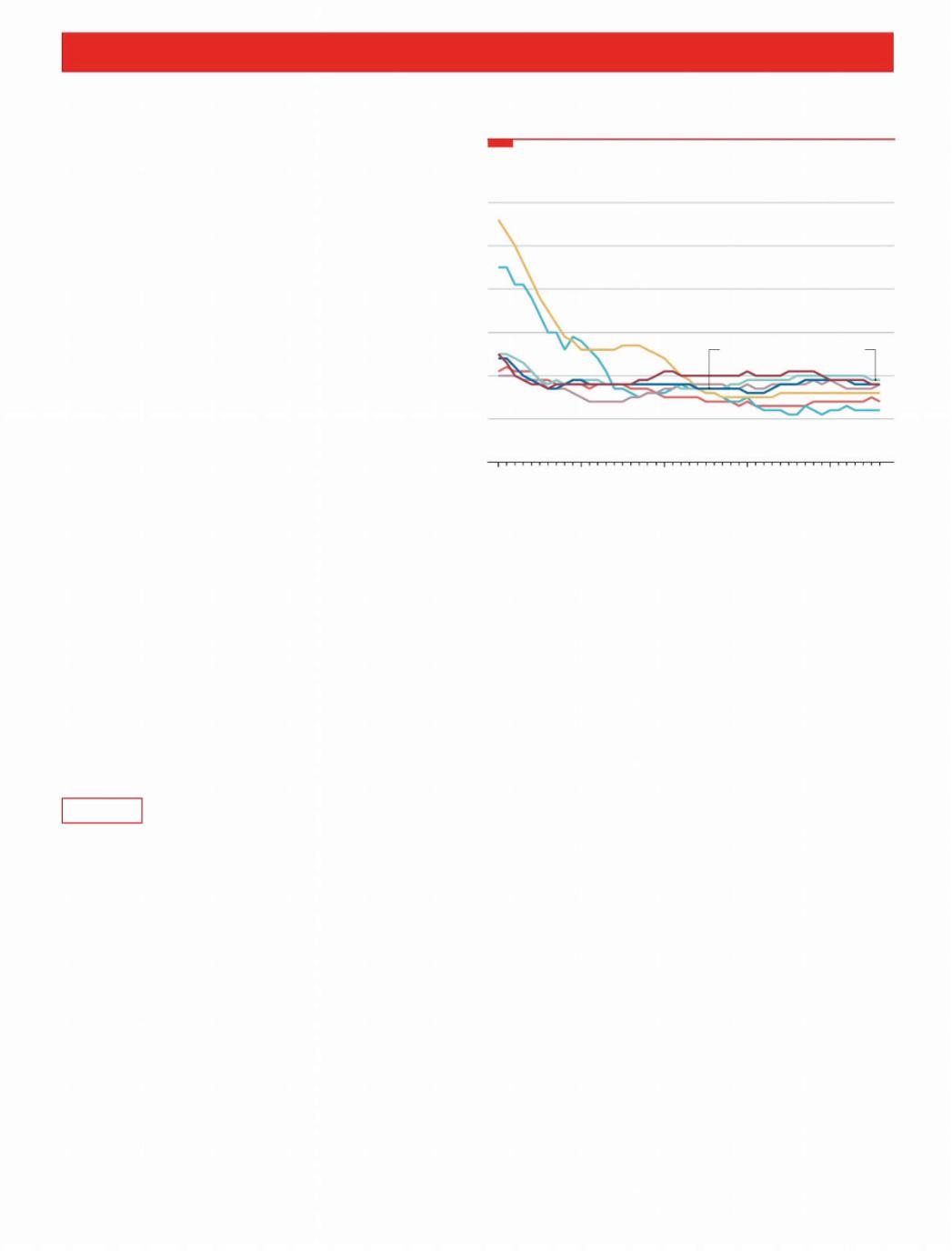
2019-01-05_The_Economist
.pdf
vk.com/id446425943
30 China
The anniversary year
Flower power
B E I J I N G
In the 70th year of Communist rule, China plans to show o every aspect of its growing might. Its anxiety will be evident, too
Beyond the Great Wall and the chain of rugged hills through which it snakes, workers are putting the finishing touches to a colossal edifice. The beams of its roof are curved, with golden tiles reminiscent of those that adorn the Forbidden City, 70km to the south-east. The building itself curves, too, in a shape that its architects say resembles a ruyi—a traditional Chinese talisman (pictured is an artist’s impression). They say it invokes a longing for fulfilment of the “Chinese dream”. That is a cherished slogan of China’s leader, Xi Jinping, whose wish is that China should emerge as a global giant. As a state news agency puts it, the building conveys the “imposing manner of
a great power”.
The China Pavilion, as the structure is called, is for an international flower festival in Yanqing, a satellite town of the capital. The show will open on April 29th and last for more than five months. It will be the biggest expo of any kind that China has staged under the aegis of the Paris-based Bureau International des Expositions since the Shanghai World Expo in 2010. It will be
the biggest horticultural one ever held anywhere. And it will be the centrepiece of the largest political celebration in China in a decade: the 70th anniversary of the founding of the Communist state. The big day itself will be on October 1st, as the flower show enters its final week.
The choreography of the coming year will convey Mr Xi’s dream to perfection. In April, on a date to be announced, foreign leaders will gather in Beijing to discuss the president’s Belt and Road Initiative—a scheme involving billions of dollars of Chinese loans to, and investment in, infrastructure projects around the world. A senior Chinese diplomat has said it will be “the most important diplomatic event” in China this year. The clout that countries wield with economic largesse is sometimes described as “hard power”. More power of an even harder kind is likely to be shown o on October 1st when, if tradition is upheld, the country’s armed might will be paraded through central Beijing: tanks, jets, nuclear missiles and thousands of troops shouting “hello chairman” to their
The Economist January 5th 2019
commander-in-chief, Mr Xi.
The flower expo will be the soft-power filling between these events and involve many times more people—16m visitors are expected, organisers say. O cials were keen to ensure that a record number of countries and international organisations would put on displays at the expo. They have succeeded: at least110 have signed up.
Many people in the capital are unaware of the scale of what will soon unfold. The site in Yanqing is on the outer periphery of Beijing municipality, far beyond its urban core (see map, next page). The Great Wall at Badaling is Yanqing’s biggest attraction. For now, tourists have little reason to head beyond it to the district’s main town, near to which, on requisitioned farmland, the expo will be held. It will be the biggest international festival in Beijing since it staged the Olympic games in 2008.
Extravaganza floribunda
On the riverside spot thousands of workers have built a 960-hectare park, half as big again as the one made for the Olympics, which was previously the city’s record-set- ter. The expo will fill the new park, with its enclosed area covering more than half of it.
It will be of huge political importance. This is reflected in the heavyweight line-up of its organising committee. It includes some of the country’s most powerful o - cials. Two of them are members of the ruling Politburo: Hu Chunhua, who is a deputy prime minister, and Cai Qi, who is the1

vk.com/id446425943
The Economist January 5th 2019
2party chief of Beijing and a protégé of Mr Xi (Mr Cai calls the expo a “glorious political task” handed to the city by the central leadership). Also on the team are 18 deputy heads of ministries (including those in charge of China’s police and spies) and Jiang Zehui, a first cousin and adoptive sister of Jiang Zemin, a former president.
Organisers have been told to let their work be guided by “Xi Jinping Thought”. They have clearly followed orders. The event will be su used with symbolic references to Mr Xi’s favourite topics, from pursuing the “Chinese dream” to creating a “beautiful China”. The expo’s o cial theme, “Live green, live better”, echoes his calls for a better environment. That the festival is taking place in a city so acutely short of water appears not to worry o cials. A diversion scheme that brings water from the distant Yangzi river basin began supplementing the city’s supply in 2014. This has freed up a reservoir near the expo site to ensure the plants stay moist.
To ease the flow of visitors, the city has been on an infrastructure spending spree. There are already two motorways, the g6 and the g7, that lead to Yanqing (visitors to the Great Wall often use them). But they are frequently congested. On January 1st a new expressway, more than 40km long, was opened. It connects the northern suburbs of the capital with Yanqing. Planning documents for the new road, called the XingYan, make it clear that the expo has been one of the main reasons for building it to this schedule. It has cost more than 13bn yuan (nearly $2bn) and involved boring a 5.9km tunnel beneath the Great Wall— about half the length of the one beneath Mont Blanc and the longest in Beijing’s road network. It has also been controversial: some environmentalists say the route threatens an ecologically sensitive area.
O cials say the new road will also be of help for the Winter Olympics in 2022, part of which will be held in Yanqing and another part in the neighbouring province of Hebei. But extending the motorway into Hebei has created a problem: the route cuts along one edge of the new park. To avoid spoiling the view, planners decided to build a 2km tunnel beneath the park and under the Guishui river, which flows through it. (For all the green-themed rhetoric of the expo, fossil-fuelled cars will play a big role. Ten car parks with a total of 22,000 spaces have been built for those who prefer to drive there.)
The view is crucial. Near the China Pavilion workers have built a hill, on the top of which they are erecting a huge four-sto- rey pavilion in ancient architectural style. It has involved a team of nearly 300 craftsmen skilled in traditional techniques. It will provide visitors with a vantage point from which to survey the expo site and the hills 10km away on which the Great Wall
Winter Olympic sites
Chongli Yan-Chong Great Wall of China
Expressway
(under
construction)
B e i j i n g
Yanqing Guishui
Expo 2019 site
Badaling
H e b e i
Xing-Yan
Expressway
Beijing
25 km
can be dimly discerned. That is important: organisers like to call the event “the horticultural expo at the foot of the Great Wall”, aiming for a soft-power multiplier e ect. The view from the pavilion provides proof of this link—on a good day. Smog sometimes renders even the hills invisible, let alone the wall.
But above all, it is the flowers that the party hopes will make its soft-power point. It loves them as a political tool. To mark the anniversary of Communist rule, Tiananmen Square is adorned every year with huge floral arrangements. The centrepiece in 2018 was in the form of a basket-shaped object with petals radiating from its base—17 metres high and 50 metres across—an assemblage of potted plants with, as always, a message (see picture). State media said they symbolised the Chinese people’s unity with the party with “Comrade Xi Jinping as the core”.
International horticultural shows are normally less to do with the national origins of plant species, and more about showing them o and sharing expertise in cultivating them. Beijing’s show will be different. One of its aims will be to highlight the global impact of Chinese flora. Visitors will be reminded that everything from tea and rice to many of the plants that are grown in Western gardens have Chinese origins. In April state television will begin showing a ten-part series called “Chinese plants that have changed the world”.
O cials worry that some Chinese may not be in a mood for celebration as the economy slows and mutterings grow about Mr Xi’s leadership. During the expo there will be sensitive dates that dissidents will be eager to mark. The first will occur just a few days after the show opens: the 100th anniversary on May 4th of a student movement that led to calls for “Mr Science” and “Mr Democracy” to be welcomed in China. The party o cially marks May 4th as youth day, but it fears appropriation of it by disaffected youngsters. The movement’s 70th anniversary in 1989 gave huge impetus to the pro-democracy unrest that engulfed
China 31
the country that year. On June 4th it will be the 30th anniversary of the crushing of those protests. Police will be on full alert. Stirrings of activism on some university campuses have already spooked them. A handful of students at Peking University staged a rare on-campus protest on December 28th against o cial interference in their Marxist student society.
Around the expo site itself, some people are grumbling. Building the venue and the new infrastructure has involved relocating hundreds, possibly thousands, of people. In Yanqing the authorities have used the expo and the games as a reason to knock down slums. A handful of residents who have refused to move vent anger at local officials for o ering what they regard as derisory sums in compensation. “Bandits,” fumes one woman. “This is all just an excuse to get money in their pockets,” says a 75-year-old retiree.
In downtown Beijing, residents have other reasons to seethe. Since November 2017, when 19 migrant workers were killed in a fire in the south of the city, the authorities have been using the pretext of fire safety to accelerate e orts to push migrants out of the city by closing places where they work and the ramshackle housing in which they live. As a result, many of Beijing’s markets have been shut down. Ironically, they include those selling cut flowers.
Chairman Mao briefly encouraged dissent with the immortal words “Let a hundred flowers bloom, let a hundred schools of thought contend”—before imprisoning or persecuting hundreds of thousands of those who took him at his word. No one, however, is likely to misinterpret the party’s signals in a year that will be florescent with symbolism. As the party often reminds o cials around the country, unrest should be nipped in the bud. 7
The party likes to say it with flowers

vk.com/id446425943
32 Britain
Housing and demography
The silver lining
Cheer up, millennials! It will become easier to buy a house. The snag? It’s because your parents are going to die
Many young Britons believe that the housing market is stacked against them. And who can blame them? In the past two decades house prices have doubled in real terms, because of both tight planning restrictions, which have limited the supply of homes, and low interest rates, which have stoked demand for them. Theresa May, the prime minister, has described the scarcity of housing as “the biggest domestic policy challenge of our generation”. But the reality is that it challenges some generations more than others. Elderly folk, who bought their houses before the boom, own a huge slice of overall housing wealth relative to their share of the population (see chart). It is a di erent story for youngsters. A 27-year-old living today is half as likely to be a home-owner as one liv-
ing15 years ago.
Yet some economists spy a silver lining for millennials. The thinking goes that, within a decade or two, baby-boomers— the bumper generation born between roughly the early 1940s and early 1960s—
will begin to sell up, as they first start to downsize, then move into elderly people’s accommodation and, eventually, to the great old-folks’ home in the sky. As their properties are put on the market, supply will rise, depressing prices and bringing ownership within reach for more people. This is much talked about in America, where a recent article co-authored by an economist at Fannie Mae, a governmentbacked mortgage provider, pointed to the “coming exodus of older homeowners”.
Back-of-the-envelope calculations give an idea of the e ect on house prices when boomers begin to sell up. England’s owneroccupier baby-boomers live in houses with an average of three bedrooms. If all of them downsized to homes with two bedrooms, that would free up housing equivalent to
Also in this section
33Paddling across the Channel
34Bagehot: The politics of patience
The Economist January 5th 2019
around 2.5% of the current stock, reckons Ian Mulheirn of Oxford Economics, a consultancy. Most empirical work shows that a 1% rise in the housing stock leads to a 2% fall in prices and rents, all else being equal. On that basis, a mass-downsizing would imply a cut in prices of about 5%.
Yet so far the British boomers are in no rush to scale down. In contrast to America, Britain does not have much of a downsizing culture. By one calculation just 40% of Britons who owned their homes at age 50 will move house before they die. A paper published in 2011 by James Banks of the Institute for Fiscal Studies, a think-tank, and colleagues, provides convincing evidence that geography and climate play a big role. In America oldsters can move to sunny climes like Florida. Britain is a bit short on such places—Cornwall, lovely as it is, is not known as the “Sunshine County”—so most pensioners don’t bother. An intrepid few retire to the continent. But Brexit is likely to make that harder.
Government policy also discourages downsizing. Stamp duty, a tax on homebuyers, makes moving expensive. As house prices have risen in the past decade, the average amount of stamp duty charged per house-purchase has risen by half in real terms (homebuyers pay around £8,000, or $10,200, in stamp duty). Meanwhile, there is little direct cost associated with remaining in a large empty nest. Council tax, an annual levy on residential property, is1

vk.com/id446425943
The Economist January 5th 2019
2 based on valuations from 25 years ago and falls relatively lightly on big, pricey houses.
If downsizing is unlikely, boomers may at least sell up when they move into an old people’s home. But here, options for elderly Britons are also limited. Perhaps 3% of British over-65s are in some sort of residential care, compared with more like 5% in America. Lawrence Bowles of Savills, a property firm, points out that Britain is under-sup- plied with good retirement housing. More than half of the existing stock was built or last refurbished more than 30 years ago. And the design of the social-care system means that most British pensioners do not need to sell their home to pay for their treatment. In their election manifesto last year the Conservatives floated a plan to include more people’s housing wealth in the test of whether they had the means to pay for their own care. After the move was dubbed the “dementia tax” it was hastily scrapped.
All this means that it may be only when baby-boomers start to check out in a more permanent way that lots of houses begin to change hands. The most common year of birth for the baby-boomer generation is 1947. Since their most common lifespan is around 87 years, Peak Death could occur in 2034, when Britain will see around 15% more fatalities than in 2018. It will be very sad. But for house-hunters it will be a help. By that time baby-boomer deaths will be pushing down on house prices by around 0.7% a year.
Yet just as the housing crisis a ects different generations unequally, the impact of the great baby-boomer sell-o will have an unequal e ect on di erent groups of youngsters. The boomers will leave record amounts of wealth to their descendants. Data are poor but according to our calculations, roughly £100bn are left behind each year. Over the next 20 years the total value of bequests is expected to more than double, peaking in 2035, according to a paper by Laura Gardiner of the Resolution Foundation, a think-tank. Most of this unearned wealth will not be taxed, on current plans. By 2020 a couple will be able to pass on a house worth £1m tax-free.
Most of the inheritance bonanza, how-
Old folks’ homes
Britain, by age group, 2017
Population, % of adults |
|
|
||
18-34 years |
35-49 |
50-64 |
65+ |
|
28 |
|
25 |
24 |
23 |
Housing wealth, % of total |
|
|
||
6 |
19 |
33 |
43 |
|
Sources: Savills; ONS
ever, will go to a relative few. Nearly half of non-homeowning millennials have no parental property wealth at all, according to Ms Gardiner’s research. The other half will be able to use their inheritance to gain greaterpurchaseinthehousingmarket,for themselves or their own heirs and heiresses. A class of wealthy oldsters is moving on, only to be replaced by a class of wealthy inheritors. Demography will put downward pressure on house prices. But some people have a lot more to look forward to than others. 7
Migration by boat
Not quite an armada
C A L A I S
Ministerial jostling helps turn a trickle of desperation into a nautical invasion
On a clear day, they can make out the promised land. The few hundred migrants in the French port of Calais who long to come to Britain are taunted by the white cli s of Dover, just 26 miles (42km) across the English Channel. Most days, some will try to hide in lorries bound for the tunnel beneath it. Only a handful elude the British customs checks in France. Most trudge back to their camp, a wasteland strewn with plastic bags where they fight o the cold with fires and, in one case, a Union flag woolly hat. “The border is too hard,” says Arthur Kwame, a 22-year-old from
Ghana. “I wish I had wings.”
British newspaper readers could be forgiven for assuming they now have. A tidal wave of front-page headlines since Christmas has chronicled a “migrant crisis”, with ministers said to be “all at sea”. Sajid Javid, the home secretary, broke o a safari jaunt in South Africa to mastermind the response to what he called a “major incident”. After criticism from backbench Tory
Britain 33
mps, he redeployed two patrol boats from the Mediterranean to the Channel and called in the navy.
About 100 migrants have risked the precarious crossing of the busy shipping lane in dinghies since Christmas rather than attempt to break into yet another lorry. This is an increase on previous months, but absolute numbers are still small. Crossings cannot be tallied definitively but the Home O ce knows of 539 migrants who tried to cross by boat in 2018, probably far fewer than the number who came by lorry. Only 312 completed the journey (the rest were caught). In contrast, 113,145 made it across the Mediterranean last year.
Far from demonstrating lax borders, the latest cases highlight the success of initiatives to tighten controls in Calais. Between 2016 and February 2018, British o cials on the continent prevented more than 80,000 “clandestine” attempts to cross the Channel. In 2017 there were 26,500 asylum applications, some 19% below the level at the height of migration in 2015. More than three times as many asylum-seekers came to Britain in 2002, a recent peak.
Nor are many in the camp keen to pay smugglers a few thousand euros to join the flotilla. Mr Kwame had not heard it was an option until journalists began visiting. If he is given the chance, he might take it, but he is reluctant, having already been rescued from the Mediterranean. As much as migrants switching tactics, the rise in crossings by boat appears to reflect the growing proportion of Iranians in Calais. Maya Konforti, who runs a charity for migrants there, says di erent nationalities favour varying routes across the Channel. “Crossing by boat has always been in great part the speciality of Iranians,” she explains, though it is not clear why. Several hundred Iranians made it to Calais via Serbia between August 2017 and October 2018, after Belgrade temporarily dropped a visa requirement. Most speak English and are keen to work.
The fuss is partly down to the deadly stakes of the migrants’ bleak calculation. Though nobody has yet drowned, it is an obvious risk, as is collision with bigger ships. But migrants also die attempting to cross through the tunnel. Politicians have done little to calm the brouhaha. Gavin Williamson, the defence secretary, quickly o ered the navy’s help. Mr Javid appointed a “gold commander” to deal with the a air. Cynics note that the crisis may help Theresa May’s potential successors burnish their leadership credentials.
Such concerns do not trouble Mr Kwame, who wants to come because he speaks English, “and besides we used to be a colony”. He has been found in lorries six times since arriving in Calais in July 2018. But he will keep trying. “I don’t need your money,” he says. “I just want to be safe.” 7

vk.com/id446425943
34 Britain The Economist January 5th 2019
Bagehot The triumph of the tortoises
British politics has been shaped by those playing the long game
Over the coming weeks the British will have plenty of chances to reflect on Harold Wilson’s dictum that “a week is a long time in politics”. As mps debate Theresa May’s Brexit deal the future of
the country will seem to hang on a tide-turning speech or a highprofile defection. But in fact high-speed politics will be a testimony to the importance of low-speed politics: the political landscape has been created by patient men who thought in terms of decades rather than weeks.
For most of their lives Brexiteers have been dismissed by the establishment as irritating protuberances who got in the way of good government. John Major called them “bastards”. Other choice epithets include “the barmy army” and “swivel-eyed loons”. They forged on regardless, convinced that they would be judged in the light of history rather than the next day’s newspapers.
The paradigmatic example of a patient man is Sir Bill Cash. Fellow Tories dismissed him as the biggest Euro-bore in Parliament. When he was prime minister David Cameron invented an antiCash device: whenever he ventured into the Commons he surrounded himself with a scrum of well-built loyalists who were instructed to keep the member for Stone at bay. But nothing deflected Sir Bill from what he calls his “Thirty Years War” to save Britain from the European super-state. He joined the select committee on European legislation in1985 and has been a member ever since, poring over the most tedious eu publications for signs of subterfuge. He founded the first grass-roots anti-eu organisation, the European Foundation. He even trained the younger generation of Eurosceptics. William Rees-Mogg, a former editor of the Times, was a close friend and Sir Bill provided his precocious son, Jacob, with lengthy tutorials.
The Brexiteers responded to every disappointment by redoubling their e orts. In the first decade of this century their project looked doomed. Their obsession with the eu had helped hand power to Tony Blair. Their choice for party leader—Iain Duncan Smith—turned out to be a nincompoop. Mr Cameron revived the Tory party by promising, in e ect, to put them back in the asylum. But their persistence eventually paid o . They exploited a chance concatenation of circumstances—public anxiety about the surge of immigrants from eastern Europe after 2004; exhaustion with
New Labour’s endless spin; the rise of ukip—to extract a promise of a referendum. The rest, as they say, is history, and history that has been made by patient men like Sir Bill rather than short-term party managers like Mr Cameron.
The triumph of the patient right has coincided with the triumph of the patient left. The Labour Party is now run by people who have spent not years but decades in the wilderness. Jeremy Corbyn was first elected mp for Islington North in 1983 (a year before Sir Bill made it to Parliament) but didn’t hold his first serious o ce until 2015 when he became leader of the opposition. Before that he spent his life as an agitator, going on demonstrations, stu ng envelopes, fraternising with activists, and sticking it to the party leadership (he defied the party whip 428 times when New Labour was in power). His closest allies are internal exiles of the same generation: John McDonnell, his shadow chancellor; Dianne Abbot, his home secretary; and, outside Parliament, Jon Lansman, the architect of Momentum, a campaign group, who made his name as Tony Benn’s fixer in the1980s.
The patient left were kept going by a burning faith that history would eventually move in their direction, a faith well illustrated by Mr McDonnell’s comment, during the financial crisis, that “I’ve been waiting for this for a generation.” While New Labour concluded that the lesson of Thatcherism was that they had to compromise to survive, Mr Corbyn’s group concluded the opposite, that they had to do a Thatcher in reverse and bend reality to their will. They defended their position in the party’s machinery by outboring their rivals. They were always the first people with a procedural motion and the last people to leave at night. As with the Brexiteers their patience eventually paid o . They were able to exploit another concatenation of circumstances—the financial crisis in 2008; Ed Miliband’s decision to expand the membership; the willingness of a few moderate mps to put Mr Corbyn’s name on the ballot—to seize control of the party.
Best of enemies
The patient people of the right and the left are now busy propping each other up. Mr Corbyn’s refusal either to support Mrs May’s Brexit deal or to sanction another vote on eu membership makes it more likely that Britain will crash out of the eu without a deal (the default option). The Brexiteers’ obsessive pursuit of a “clean Brexit” is tearing the Conservative Party apart and making it more likely that a furious electorate will vote Labour. Over the next couple of years both groups of patient men may get what they want: a hard Brexit for the Brexiteers this March and a Corbyn-led Labour government for the left.
What lessons should we learn from the rise of the patient tendency? The first is not to put too much hope in last minute compromises. You don’t devote your life to a waiting game only to discover the virtue of pragmatism at the eleventh hour. The Brexiteers think that the shock of a hard-Brexit will be a small price to pay for regaining the country’s freedom. Mr Corbyn thinks that chaos might well be the midwife of a glorious socialist future.
The second lesson is that long-termism can be overrated. It is conventional to decry the tyranny of short-term thinking, a tyranny that is supposedly getting more oppressive in a world of Twitter mobs and one-click consumers. But long-termism can be coupled with monomania and utopianism. And short-termism makes for constant adjustments to an ever-changing reality. Britain’s patient tendency is doing far more harm to the country than short-termists ever did. 7

vk.com/id446425943
SPECIAL
REPORT:
Childhood
→ January 5th 2019
3 The generation game
4 History
5 The family
7 Early years
8 Digital media
10 Parenting
12 An unfair world
The generation game

vk.com/id446425943

vk.com/id446425943
Special report Childhood
The Economist January 5th 2019 3
The generation game
In just a few decades childhood has changed out of all recognition, says Barbara Beck. What does that mean for children, parents and society at large?
“When i was a kid, we were out and about all the time, playing with our friends, in and out of each other’s houses, sandwich in pocket, making our own entertainment. Our parents hardly saw us from morning to night. We didn’t have much stu , but we came and went as we liked and had lots of adventures.” This is roughly what you will hear if you ask anyone over 30 about their childhood in a rich country. The adventures were usually of a homely kind, more Winnie the Pooh than Star Wars, but the free-
dom and the companionship were real.
Today such children will spend most of their time indoors, often with adults rather than with siblings or friends, be supervised more closely, be driven everywhere rather than walk or cycle, take part in many more organised activities and, probably for several hours every day, engage with a screen of some kind. All this is done with the best of intentions. Parents want to protect their o spring from tra c, crime and other hazards in what they see as a more dangerous world, and to give them every opportunity to flourish.
And indeed in many ways children are better o than they were a generation or two ago. Child mortality rates even in rich countries are still dropping. Fewer kids su er neglect or go hungry. They generally get more attention and support from their parents, and many governments are o ering extra help to very young children from disadvantaged backgrounds. As adolescents, fewer become delinquents, take up smoking and drinking or become teenage parents. And more of them finish secondary school and go on to higher education.
The children themselves seem fairly happy with their lot. In a survey across the oecd in 2015,15-year-olds were asked to rate their satisfaction with their life on a scale from zero to ten. The average
score was 7.3, with Finnish kids the sunniest, at nearly 7.9, and Turkish ones the gloomiest, at 6.1. Boys were happier than girls, and children from a uent families scored higher than the rest.
That is not surprising. Prosperous parents these days, especially in America, invest an unprecedented amount of time and money in their children to ensure that they will do at least as well as the parents themselves have done, and preferably better. Those endless rounds of extra tutoring, music lessons, sports sessions and educational visits, together with lively discussions at home about every subject under the sun, have proved highly e ective at securing the good grades and social graces that will open the doors to top universities and well-paid jobs.
Working-class parents in America, for their part, lack the wherewithal to engage in such intensive parenting. As a result, social divisions from one generation to the next are set to widen. Not so long ago the “American dream” held out the prospect that everyone, however humble their background, could succeed if they tried hard enough. But a recent report by the World Bank showed that intergenerational social mobility (the chance that the next generation will end up in a di erent social class from the previous one) in the land of dreams is now among the lowest in all rich countries. And that is before many of the social e ects of the new parenting gap have had time to show up yet.
Tell me the ways
This special report will explain what has led to these momentous changes in childhood in America and other rich countries, as well as in middle-income China. They range from broad social and demographic trends such as urbanisation, changes in family struc-1

vk.com/id446425943
4 Special report Childhood The Economist January 5th 2019
2ture and the large-scale move of women into the labour force in recent decades to a shifting emphasis in policy on the early years and the march of digital technology.
Start with the physical environment in which children are growing up. In rich countries the overwhelming majority now lead urban lives. Almost 80% of people live in cities, which have many advantages, including better opportunities for work, education, culture and leisure. But these often come at a cost: expensive housing, overcrowding, lack of green space, heavy tra c, high air pollution and a sense of living among strangers rather than in a closeknit community. This has caused a perception of growing danger, even though crime in Western countries in the past few decades has declined, so statistically the average child is actually safer.
Even more important, the domestic environment for most children has changed profoundly. Families have become smaller, and women bear children far later than they did only a couple of generations ago. In the vast majority of rich countries the average number of children a woman will have is now well below the replacement level of 2.1. Households with just one child have become
commonplace in Europe and the more prosperous parts of Asia, including China. That means each child has more time, money and energy invested in it, but misses out on the hustle and bustle of a larger household.
Families have also become far more fluid. Rates of marriage have declined steeply, and divorce has become widespread. Many couples in America and Europe now cohabit rather than marry, and a large and growing proportion of children are born out of wedlock. Far more of them, too, are being brought up by lone parents, overwhelmingly mothers, or end up in patchwork families created by new sets of relationships. Again, this happens far more often at the bottom of the social scale than at the top.
At the same time the number of women going out to work has risen steeply, though in recent years the trend has slowed. The post-second-world-war model of the nuclear family with a breadwinner husband, a homemaker wife and several children has become atypical. In America the share of women of working age in the labour force has risen from 42% in 1960 to 68% in 2017. To a greater or lesser extent the same has happened in other rich coun-1
Little man or little angel?
How perceptions of childhood have changed through history
For most of Western history, childhood was nasty, brutish and short, or
even non-existent. Before modern medicine and public-health standards, many infants did not live to see their first birthday—and if they did, they were expected to grow up at the double. In the two millennia from antiquity to the17th century, children were mostly seen as imperfect adults. Medieval works of art typically depict them as miniature grown-ups. In1960 one of the first historians of childhood, Philippe Ariès, declared that in medieval Europe the idea of childhood did not exist. Most people were not even sure of their own age.
For much of that time newborns were considered intrinsically evil, burdened with original sin from which they had to be redeemed through instruction and education. That changed in the17th century, when children instead began to be seen as innocents who must be protected from harm and corruption by the adult world. Childhood came to be regarded as a separate stage of life. John Locke, a17th-century English thinker, saw the mind of a newborn child as a blank sheet, to be filled in by its elders and betters. A few decades later JeanJacques Rousseau, a Swiss philosopher, argued that children had their own way of seeing, thinking, feeling and reasoning and should be left to develop as nature intended. In the late18th and early 19th century the Romantics went one better, crediting children with deeper
wisdom than adults.
Parents’ relative lack of interest in their children in the Middle Ages may have been a rational response to a distressingly high infant mortality rate, reckoned to have been around 200-300 per1,000 live births in the first year of life, compared with single figures per1,000 in rich countries now. Many others were wiped out by diseases and accidents before the age of ten. Parents would not want to get too attached to a child who might not be around for long. Besides, in the absence of reliable birth control, families tended to be large,
so less attention would be focused on each individual sibling.
Young children were encouraged to take part in adult activities as soon as they were able, usually starting between the ages of five and seven, and begin to work alongside grown-ups as they became more capable. In agrarian societies they had always been expected to help out at home and in the fields from an early age. In post-revolutionary America they were expected to become independent as soon as possible because labour was in short supply, which made the relationship between the generations less hierarchical than in Europe.
The Industrial Revolution turned children into an indispensable source of income for many poor families, often before they were fully grown. In Britain a parliamentary report in1818-19 on children in cotton mills around Stockport and Manchester put the average age for starting work at around11½.
But by the end of the19th century the state had begun to clamp down on the exploitation of children in the West. Education for the younger age groups became mandatory in ever more countries. Children were seen as in need of protection, and their period of economic dependency lengthened in both Europe and America. The scene was set for the emergence of what Viviana Zelizer, a sociologist at Princeton, has memorably described as “the economically useless but emotionally priceless child”.

vk.com/id446425943
The Economist January 5th 2019
2tries. Mothers now mostly return to work within a year or so of giving birth, not five or ten years later. In the absence of a handy grandmother, the child, even at a young age, will probably be looked after outside the home during the working week.
The first few years of a child’s life are now receiving more attention as new evidence has emerged about its vital importance in the development of the brain. James Heckman, a Nobel prize-winning American economist, has suggested that early investment in a range of measures from high-quality child care to support programmes for parents o ers excellent returns, far better than remedial interventions later in life.
Governments in many countries have started to increase the number of public child-care and kindergarten places to supplement private provision, both to encourage more women to take paid jobs and to promote the development of young children from less privileged backgrounds. This report will look at the wide variety of early-years care on o er in di erent countries (ranging from plentiful and relatively cheap in the Nordics to scarce and often eye-wateringly expensive in the Anglo-Saxon countries, with most of the rest of Europe somewhere in between), and try to assess what di erence it makes. In East Asia this is the first rung of a fiercely competitive educational ladder.
The report will also consider the e ect on children of an array of screen-based devices, from televisions to smartphones, o ering a feast of passive entertainment, interactive computer games and the opportunity to connect with peers remotely. Not long ago children used to rile their parents by declaring they were bored, but now “being bored is something that never has to be tolerated for a moment”, writes Sherry Turkle of mit, an expert on digital culture. In rich countries the vast majority of 15-year-olds have their own smartphone and spend several hours a day online. There are growing concerns that overuse might lead to addiction and mental illness, and that spending too much time sitting still in front of a screen will stop them from exercising and make them fat. The digital world also harbours new risks, including cyberbullying and sexting.
But the first thing this report will explore is the new face of the institution still central to any child’s life: the family. 7
The family
Essential ingredient
Smaller, more heterogeneous, but still indispensable
On a rainy Saturday morning, the Museum of Childhood in east London reverberates with the sound of hundreds of small children enjoying themselves. Some are stacking bricks, others are playing in a sandpit as their parents look on. A large Victorian rocking horse attracts a queue of young riders. On a nearby wall a notice outlines a project on which the museum worked with a local school to find out what sevenand eight-year-olds consider important in their lives. The clear winners were the children’s fam-
ilies—along with Lego, a construction toy.
The family is still the best place for a child to get the love and security it needs to grow into a well-balanced adult. Child-develop- ment experts agree that almost any family, however imperfect, is better than none at all. It does not even have to last for ever, only long enough to provide a safe and warm space for those crucial early years. That is just as well, because today’s families are very dif-
Special report Childhood 5
Two is plenty
Total fertility rate*
6
China
5
4
South
Korea
3
|
|
|
Britain |
United France |
|
|
|
|
|
States |
2 |
|
|
|
|
|
|
|
Denmark |
|
Japan |
|
1 |
|
|
|
|
|
|
|
|
|
|
|
0 |
1970 |
80 |
90 |
2000 |
10 |
16 |
Source: OECD |
*Number of children a woman is likely to have in her lifetime |
||||
ferent from those of a few decades ago.
Most obviously, they are smaller. Across the oecd, the total fertility rate (tfr)—the number of children a woman is likely to have in her lifetime—is now 1.7, against 2.7 in 1970 (see chart). Even America, which until recently used to procreate more than most of the West, is now close to the rich-country average. In South Korea the fall in the tfr has been precipitous, from 4.5 in1970 to1.2 now.
The road from five to one
Over the same period China’s tfr has plummeted from 5.6 to 1.6. That is often attributed to the country’s one-child policy, but the ultra-low birth rates of other countries in the region, including Japan, South Korea, Taiwan and Vietnam, suggest it would have happened anyway, if somewhat later. In 2016 the Chinese government, alarmed by the prospect of a rapid decline in the country’s working population, relaxed the rules. That brought a small uptick, but by the following year the numbers were down again. In time the policy is likely be scrapped altogether, but no one expects a baby boom.
Asked what is holding them back from having larger families, Chinese couples often cite the cost of raising children. But the country’s increasing urbanisation has also played a part. Many of its modern cities are just as crowded, tra c-ridden, polluted and devoid of green spaces as those in the West, if not more so. They are uninviting places in which to bring up a family.
Both in China and throughout the rich world, couples marry far later than they used to, and have their first child when they are much older. At the start of the 1990s in most oecd countries the mean age of women at first marriage was between 22 and 27, and for men two or three years older; now it is 30 for women and over 32 for men. In Sweden, the place with the oldest brides and grooms, it is 34 and 36 respectively.
And many no longer bother to get married at all. In the past half-century marriage rates in the developed world have roughly halved, though there are big di erences between countries, and not necessarily along the lines you might expect. Americans, for example, marry at twice the rate of Italians, French and Spaniards. The Chinese are keenest of all, reflecting a strong aversion to births out of wedlock, for both cultural and practical reasons.
In most rich countries such attitudes are a thing of the past. The average proportion of children born to unmarried parents across the oecd is now around 40%, compared with 7.5% back in 19701
